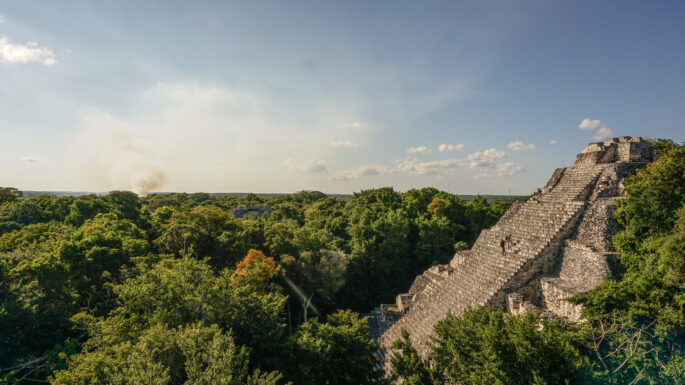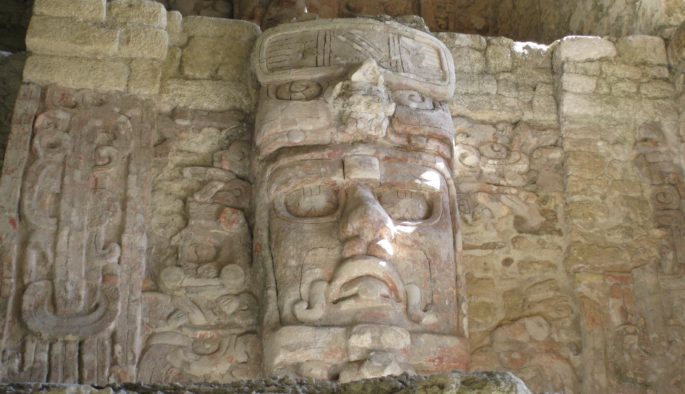
The ancient Maya civilization, renowned for their advanced understanding of astronomy, mathematics, and spirituality, left behind a legacy that continues to intrigue and captivate scholars and seekers alike. In this illuminating post, we rediscover the profound wisdom embedded within their intricate calendars, sacred sites, and cosmological beliefs.
We will venture into a world where time is cyclical, where the movements of celestial bodies are intricately woven into the fabric of daily life, and where the journey of the soul is guided by the rhythms of the cosmos. We will uncover the interconnectedness of all things, the sacredness of nature, and the eternal dance between light and darkness.
Unveiling the Maya Calendar: Understanding the Cyclical Nature of Time
The Maya civilization’s calendar system stands as one of their most enduring legacies, a testament to their advanced understanding of time and the cosmos. At the heart of this intricate system lies a profound appreciation for the cyclical nature of time, a concept that differs significantly from the linear perception of time prevalent in many other cultures.
The Maya calendar is composed of several interlocking cycles, each with its own significance and duration. Among the most well-known are the Tzolk’in, or Sacred Round, and the Haab’, or Solar Year. The Tzolk’in consists of 260 days and is composed of a combination of 20 day names and 13 numbers, resulting in a cycle where each day is uniquely defined. This cycle intertwines with the Haab’, a solar calendar comprising 18 months of 20 days each, plus a final month of 5 days, known as the Wayeb’. Together, these calendars create a more extensive cycle known as the Calendar Round, which repeats every 52 years.
However, the Maya calendar system extends far beyond these basic cycles, encompassing longer counts such as the famous Long Count. This system, famously associated with the Maya calendar end-date of December 21, 2012, measures time in units of days, akin to our modern Gregorian calendar. Yet, it also incorporates higher-order cycles, reflecting the Maya’s understanding of time as a multi-layered tapestry of interlocking cycles.
The Maya calendar system served as a tool for agricultural planning, religious ceremonies, and political governance, intricately woven into the fabric of daily life. Moreover, the cyclical nature of the calendar reflects the Maya worldview, wherein time is not perceived as a linear progression but as a series of recurring cycles, each with its own significance and lessons to impart.
By delving into the intricacies of the Maya calendar system, we gain not only a deeper understanding of their culture and beliefs but also a broader perspective on the nature of time itself. In a world where time often feels relentless and linear, the Maya reminds us of the cyclical rhythms that underpin existence, inviting us to embrace a more holistic understanding of time and cosmic cycles.
Sacred Sites and Celestial Alignments: Revealing the Spiritual Connection between Earth and Sky
The ancient Maya regarded their landscape not only as a physical realm but also as a sacred canvas intricately connected to the celestial heavens. Their sacred sites, often meticulously constructed and strategically positioned, served as focal points for rituals, ceremonies, and astronomical observations, reflecting the profound relationship between the earthly realm and the celestial spheres.
One of the most striking features of Maya sacred sites is their alignment with celestial phenomena, such as the movements of the sun, moon, and stars. Throughout the Maya world, temples, pyramids, and other architectural marvels were carefully oriented to coincide with significant astronomical events, such as solstices, equinoxes, and the passage of celestial bodies across the horizon.

For example, sites like Calakmul and Becán in present-day Mexico were strategically built in alignment with celestial events such as solstices and equinoxes. Their structures, including pyramids and temples, were positioned to correspond with the movement of celestial bodies including the sun, moon, and stars.
These celestial alignments were not merely practical considerations but held profound spiritual significance for the Maya. They believed that the positioning of sacred sites in alignment with celestial events facilitated communication with the gods, facilitated agricultural cycles, and ensured the well-being of their communities. Moreover, the alignment of temples and pyramids with celestial bodies symbolized the connection between the earthly realm and the divine, serving as conduits for spiritual energy and cosmic forces.
By exploring the significance of Maya sacred sites and their alignment with celestial phenomena, we gain insights into the Maya worldview, wherein the physical and spiritual realms are intimately intertwined. In doing so, they remind us of the deep spiritual connection that exists between humanity and the celestial realms, inviting us to contemplate our place in the cosmos and the mysteries that lie beyond.
Cosmic Mythology and Spiritual Wisdom: Unraveling the Mysteries of Maya Mythology
Rooted in a deep reverence for nature and the divine, Maya mythology provides a window into their cosmological beliefs, spiritual practices, and worldview, offering timeless wisdom that continues to resonate with modern seekers.
Central to Maya mythology are the stories of their gods and goddesses, who embody various aspects of the natural world and cosmic forces. Among the most prominent figures are the Hero Twins, Hunahpu and Xbalanque, whose adventures in the underworld and triumph over the forces of darkness symbolize the eternal struggle between light and darkness, life and death. Through their journey, we glimpse the Maya understanding of the cyclical nature of existence.
Another key figure in Maya mythology is the Maize God, often depicted as a youthful deity associated with agriculture, fertility, and renewal. His sacrifice and resurrection symbolize the cycle of planting, growth, and harvest, reflecting the Maya’s deep spiritual connection to the land and the rhythms of nature. Indeed, many Maya myths are imbued with agricultural symbolism, underscoring the vital importance of agriculture in their society and the recognition of nature as a divine force to be revered and respected.
Yet, beyond the tales of gods and heroes, Maya mythology is replete with symbols and allegories that carry profound spiritual meaning. From the sacred ceiba tree, whose roots connect the underworld, the earth, and the heavens, to the cosmic serpent, symbolizing the life force that flows through all creation, Maya symbols serve as gateways to deeper understanding and spiritual insight.
For modern seekers, Maya mythology serves as a source of inspiration and guidance on the journey of self-discovery and spiritual awakening. By delving into these ancient tales, we unlock the keys to understanding ourselves and our place in the universe, discovering that the wisdom of the Maya is as relevant today as it was millennia ago. In their stories and symbols, we find echoes of our own struggles, aspirations, and aspirations, guiding us towards a deeper connection with the divine and a greater appreciation for the mysteries of life.

Embracing the Wisdom of Maya Cosmology
As we conclude our exploration of Maya cosmology, we emerge with a newfound appreciation for the profound wisdom encoded within their ancient civilization. From the intricacies of the Maya calendar system to the celestial alignments of sacred sites, and the timeless myths and symbols that illuminate their spiritual worldview, we have journeyed through a landscape of mystery and wonder.
The Maya remind us that the pursuit of knowledge is not merely an intellectual endeavor but a spiritual quest, a journey of self-discovery and awakening to the mysteries of existence. In their reverence for the natural world, their understanding of time as cyclical, and their recognition of the interconnectedness of all things, we find echoes of timeless truths that resonate with the deepest reaches of our souls.
If you wish to explore the lesser-known sites of Mexico with Mayan Master Teacher Miguel Angel Vergara such as Edzná, Balamkú, Becán; Xpujil, Chicannáh, Kohunlich join us on our journey in March 2025, where we will engage in teachings, ceremonies, and meditations related to the Cosmic Serpent, a symbol of rebirth and renewal, and the Sun, our sacred central star.

